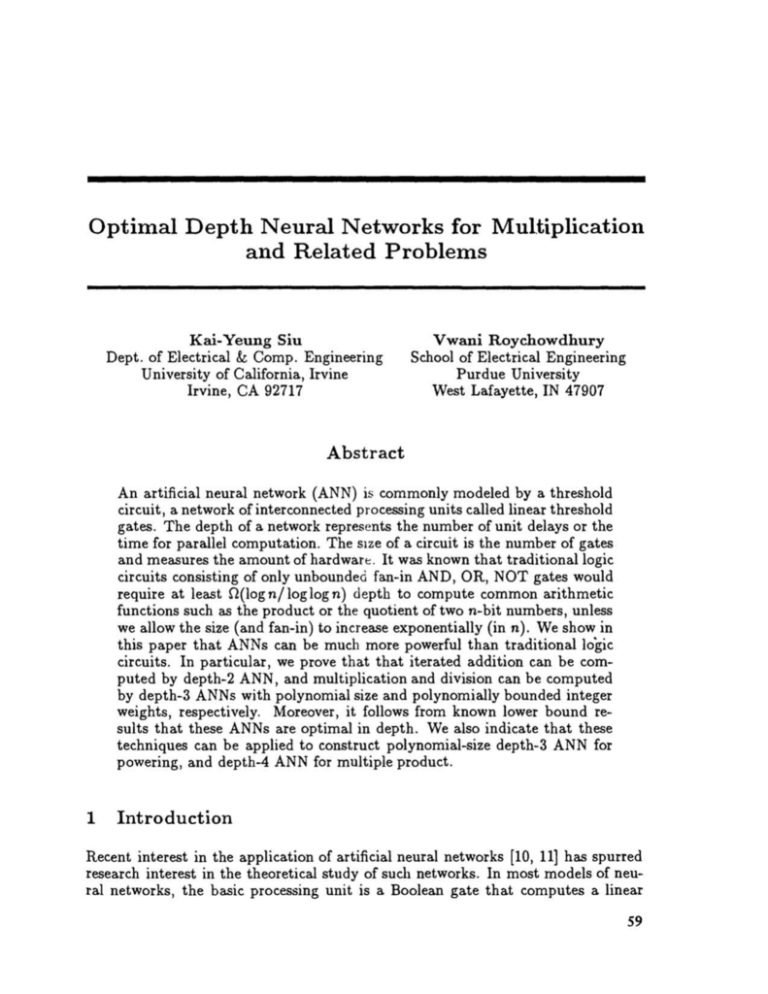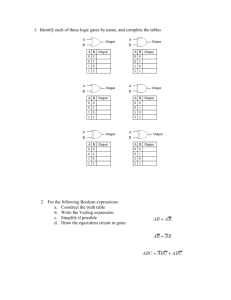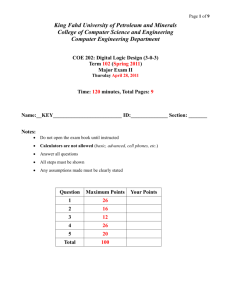Optimal Depth Neural Networks for Multiplication and Related
advertisement

Optimal Depth Neural Networks for Multiplication
and Related Problems
Kai-Yeung Siu
Dept. of Electrical & Compo Engineering
University of California, Irvine
Irvine, CA 92717
Vwani Roychowdhury
School of Electrical Engineering
Purdue University
West Lafayette, IN 47907
Abstract
An artificial neural network (ANN) is commonly modeled by a threshold
circuit, a network of interconnected processing units called linear threshold
gates. The depth of a network represents the number of unit delays or the
time for parallel computation. The SIze of a circuit is the number of gates
and measures the amount of hardware . It was known that traditional logic
circuits consisting of only unbounded fan-in AND, OR, NOT gates would
require at least O(log n/log log n) depth to compute common arithmetic
functions such as the product or the quotient of two n-bit numbers, unless
we allow the size (and fan-in) to increase exponentially (in n). We show in
this paper that ANNs can be much more powerful than traditional logic
circuits. In particular, we prove that that iterated addition can be computed by depth-2 ANN, and multiplication and division can be computed
by depth-3 ANNs with polynomial size and polynomially bounded integer
weights, respectively. Moreover, it follows from known lower bound results that these ANNs are optimal in depth. We also indicate that these
techniques can be applied to construct polynomial-size depth-3 ANN for
powering, and depth-4 ANN for mUltiple product.
1
Introduction
Recent interest in the application of artificial neural networks [10, 11] has spurred
research interest in the theoretical study of such networks. In most models of neural networks, the basic processing unit is a Boolean gate that computes a linear
59
60
Siu and Roychowdhury
threshold function, or an analog element that computes a sigmoidal function. Artificial neural networks can be viewed as circuits of these processing units which are
massively interconnected together.
While neural networks have found wide application in many areas, the behavior
and the limitation of these networks are far from being understood. One common
model of a neural network is a threshold circuit. Incidentally, the study of threshold
circuits, motivated by some other complexity theoretic issues, has also gained much
interest in the area of computer science. Threshold circuits are Boolean circuits in
which each gate computes a linear threshold function, whereas in the classical model
of unbounded fan-in Boolean circuits only AND, OR, NOT gates are allowed. A
Boolean circuit is usually arranged in layers such that all gates in the same layer are
computed concurrently and the circuit is computed layer by layer in some increasing
depth order. We define the depth as the number of layers in the circuit. Thus each
layer represents a unit delay and the depth represents the overall delay in the
computation of the circuit .
2
Related Work
Theoretical computer scientists have used unbounded fan-in Boolean circuits as
a model to understand fundamental issues of parallel computation. To be more
specific, this computational model should be referred to as unbounded fan-in parallelism, since the number of inputs to each gate in the Boolean circuit is not bounded
by a constant. The theoretical study of unbounded fan-in parallelism may give us
insights into devising faster algorithms for various computational problems than
would be possible with bounded fan-in parallelism. In fact, any nondegenerate
Boolean function of n variables requires at least O(log n) depth to compute in a
bounded fan-in circuit. On the other hand, in some practical situations, (for example large fan-in circuits such as programmable logic arrays (PLAs) or multiple
processors simultaneously accessing a shared bus), unbounded fan-in parallelism
seems to be a natural model. For example, a PLA can be considered as a depth-2
AND/OR circuit.
In the Boolean circuit model, the amount of resources is usually measured by the
number of gates, and is considered to be 'reasonable' as long as it is bounded
by a polynomial (as opposed to exponential) in the number of the inputs. For
example, a Boolean circuit for computing the sum of two n-bit numbers with O(n 3 )
gates is 'reasonable', though circuit designers might consider the size of the circuit
impractical for moderately large n. One of the most important theoretical issues in
parallel computation is the following: Given that the number of gates in the Boolean
circuit is bounded by a polynomial in the size of inputs, what is the minimum depth
(i.e. number of layers) that is needed to compute certain functions?
A first step toward answering this important question was taken by Furst et al. [4]
and independently by Ajtai [2]. It follows from their results that for many basic
functions, such as the parity and the majority of n Boolean variables, or the multiplication of two n-bit numbers, any constant depth (i. e. independent of n) classical
Boolean circuit of unbounded fan-in AND/OR gates computing these functions
must have more than a polynomial (in n) number of gates. This lower bound on
the size was subsequently improved by Yao [18] and Hastad [7]; it was proved that
Optimal Depth Neural Networks for Multiplication and Related Problems
indeed an exponential number of AND/OR gates are needed. So functions such as
parity and majority are computationally 'hard' with respect to constant depth and
polynomial size classical Boolean circuits. Another way of interpreting these results
is that circuits of AND/OR gates computing these 'hard' functions which use polynomial amount of chip area must have unbounded delay (i. e. delay that increases
with n). In fact, the lower bound results imply that the minimum possible delay
for multipliers (with polynomial number of AND/OR gates) is O(logn/loglogn).
These results also give theoretical justification why it is impossible for circuit designers to implement fast parity circuit or multiplier in small chip area using AND,
OR gates as the basic building blocks.
One of the 'hard' functions mentioned above is the majority function, a special case
of a threshold function in which the weights or parameters are restricted. A natural
extension is to study Boolean circuits that contain majority gates. This type of
Boolean circuit is called a threshold circuit and is believed to capture some aspects
of the computation in our brain [12]. In the rest of the paper, the term 'neural
networks' refers to the threshold circuits model.
With the addition of majority gates, the resulting Boolean circuit model seems
much more powerful than the classical one. Indeed, it was first shown by Muroga
[13] three decades ago that any symmetric Boolean function (e.g. parity) can be
computed by a two-layer neural network with (n + 1) gates. Recently, Chandra
et al. [3] showed that multiplication of two n-bit numbers and sorting of n n-bit
numbers can be computed by neural networks with 'constant' depth and polynomial
size. These 'constants' have been significantly reduced by Siu and Bruck [14, 15] to
4 in both cases, whereas a lower bound of depth-3 was proved by Hajnal et al. [6]
in the case of multiplication. It is now known [8] that the size of the depth-4 neural
networks for multiplication can be reduced to O(n 2 ). However, the existence of
depth-3 and polynomial-size neural networks for multiplication was left as an open
problem [6, 5, 15] since the lower bound result in [6]. In [16], some depth-efficient
neural networks were constructed for division and related arithmetic problems; the
networks in [16] do not have optimal depth.
Our main contribution in this paper is to show that small constant depth neural
networks for multiplication, division and related problems can be constructed. For
the problems such as iterated addition, multiplication, and division, the neural networks constructed can be shown to have optimal depth. These results have the
following implication on their practical significance: Suppose we can use analog devices to build threshold gates with a cost (in terms of delay and chip area) that is
comparable to that of AND, OR, logic gates, then we can compute many basic functions much faster than using traditional circuits. Clearly, the particular weighting
of depth, fan-in, and size that gives a realistic measure of a network's cost and speed
depends on the technology used to build it. One case where circuit depth would
seem to be the most important parameter is when the circuit is implemented using
optical devices. We refer those who are interested in the optical implementation of
neural networks to [1].
Due to space limitations, we shall only state some of the important results; further
results and detailed proofs will appear in the journal version of this paper [17].
61
62
Siu and Roychowdhury
3
Main Results
Definition 1
Given n n-bit integers, Zi = Lj~; zi,i2i, i = 1, ... , n, zi,i E {O, I},
We define iterated addition to be the problem of computing the (n + log n )-bit sum
L~=l Zi of the n integers.
=
=
Definition 2
Given 2 n-bit integers, x
Lj==-~ xi2i and Y Lj==-~ Yi2i. We
define multiplication to be the problem of computing the (2n)-bit product of x and
y.
Using the notations of [15], let us denote the class of depth-d polynomial-size neural
networks where the (integer) weights are polynomially bounded by & d and the
corresponding class where the weights are unrestricted by LTd. It is easy to see that
if it~ated addition can be computed in &2, then multiplication can be computed
in LT 3 . We first prove the result on iterated addition. Our result hinges on a
recent striking result of Goldmann, Hcistad and Razborov [5]. The key observation
is that iterated addition can be computed as a sum of polynomially many linear
threshold (LTd functions (with exponential weights). Let us first state the result
of Goldmann, Hastad and Razborov [5].
Lemma 1
[5] Let LTd denote the class of depth-d polynomial-size neural networks where the weights at the output gate are polynomially bounded integers (with
no restriction on the weights of the other gates). Then LTd = & d for any fixed
integer d ~ 1.
The following lemma is a generalization of the result in [13]. Informally, the result
says that if a function is 1 when a weighted sum (possibly exponential) of its inputs
lies in one of polynomially many intervals, and is 0 otherwise, then the function can
be computed as a sum of polynomially many LTI functions.
Lemma 2
Let S = L7=1 WiXi and f(X) be a function such that f = 1 if S E
[Ii, ud for i = 1, ... , Nand f = 0 otherwise, where N is polynomially bounded.
The~ can be computed as a sum of polynomially many LTI functions and thus
f E LT2 ·
Combining the above two lemmas yields a depth-2 neural network for iterated addition.
.-
Theorem 1
Iterated addition is in LT2 •
It is also easy to see that iterated addition cannot be computed in LTI
Simply
observe that the first bit of the sum is the parity function, which does not belong
to LT1 . Thus the above neural network for iterated addition has minimum possible
depth.
Theorem 2
Multiplication of 2 n-bit integers can be computed in
.
LT3.
It follows from the results in [6] that the depth-3 neural network for multiplication
stated in the above theorem has optimal depth.
Optimal Depth Neural Networks for Multiplication and Related Problems
We can further apply the results in [5] to construct small depth neural networks for
division, powering and multiple product. Let us give a formal definition of these
problems.
Definition 3
Let X be an input n-bit integer
2
n -bit representation of xn.
~
O. We define powering to be the
Definition 4
Given n n-bit integers Zi, i = 1, ... , n, We define multiple product
2
to be the n -bit representation of n~=l Zi.
Suppose we want to compute the quotient of two integers. Some quotient in binary representation might require infinitely many bits, however, a circuit can only
compute the most significant bits of the quotient. If a number has both finite and
infinite binary representation (for example 0.1 = 0.0111 ... ), we shall always express
the number in its finite binary representation. We are interested in computing the
truncated quotient, defined below:
=
Definition 5
Let X and Y ~ 1 be two input n bit integers. Let X /Y
L~;~oo zi 2i be the quotient of X divided by Y. We define DIVk(X/Y) to be
X/Y truncated to the (n + k)-bit number, i.e.
o
In particular, DIVo(X /Y) is l X /Y J, the greatest integer ~ X /Y.
Theorem 3
-.
1. Powering can be computed in LT3 .
2. DIVk(x/y) can be computed in
Lr3 .
3. Multiple Product can be computed in
LT4 .
It can be shown from the lower-bound results in [9] that the neural networks for
division are optimal in depth.
References
[1] Y. S. Abu-Mostafa and D. Psaltis. Optical Neural Computers. Scientific American
, 256(3) :88-95, 1987.
L~ -formulae on finite structures. Annals of Pure and Applied Logic,
24:1-48, 1983.
[2] M. Ajtai.
[3] A. K. Chandra, 1. Stockmeyer, and U. Vishkin. Constant depth reducibility. Siam
J. Comput., 13:423-439, 1984.
[4] M. Furst, J. B. Saxe, and M. Sipser. Parity, Circuits and the Polynomial-Time
Hierarchy. IEEE Symp. Found. Compo Sci., 22:260-270, 1981.
[5] M. Goldmann, J. Hastad, and A. Razborov. Majority Gates vs. General Weighted
Threshold Gates. preprint, 1991.
63
64
Siu and Roychowdhury
[6] A. Hajnal, W. Maass, P. Pudlak, M. Szegedy, and G. Turan. Threshold circuits of
bounded depth. IEEE Symp. Found. Compo Sci., 28:99-110, 1987.
[7] J. H1stad and M. Goldmann.
On the power of small-depth threshold circuits.
InProceedings of the 31st IEEE FOCS, pp. 610-618, 1990.
[8] T. Hofmeister, W. Hohberg and S. Kohling . Some notes on threshold circuits and
multiplication in depth 4. Information Processing Letters, 39:219-225, 1991.
[9] T. Hofmeister and P. PudIa.k, A proof that division is not in TC~. Forschungsbericht
Nr. 447, 1992, Uni Dortmund.
[10] J. J. Hopfield. Neural Networks and physical systems with emergent collective computational abilities. Proceedings of the National Academy of Sciences, 79:2554-2558,
1982.
[11] J. L. McClelland D. E. Rumelhart and the PDP Research Group. Parallel Distributed
Processing: Explorations in the Microstructure of Cognition, vol. 1. MIT Press, 1986.
[12] W. S. McCulloch and W. Pitts. A Logical Calculus of Ideas Immanent in Nervous
Activity. Bulletin of Mathematical Biophysics, 5:115-133, 1943.
[13] S. Muroga. The principle of majority decision logic elements and the complexity of
their circuits. Inti. Con/. on Information Processing, Paris, France, June 1959.
[14] K. Y. Siu and J. Bruck. Neural Computation of Arithmetic Functions. Proc. IEEE,
78, No. 10:1669-1675, October 1990. Special Issue on Neural Networks.
[15] K.-Y. Siu and J. Bruck. On the Power of Threshold Circuits with Small Weights.
SIAM J. Discrete Math., 4(3):423-435, August 1991.
[16] K.-Y. Siu, J. Bruck, T. Kailath, and T. Hofmeister. Depth-Efficient Neural Networks
for Division and Related Problems . to appear in IEEE Trans. Information Theory,
1993.
[17] K.- Y. Siu and V. Roychowdhury.
On Optimal Depth Threshold Circuits for Mulitplication and Related Problems. to appear in SIAM J. Discrete Math.
[18] A. Yao.
Separating the polynomial-time hierarchy by oracles. IEEE Symp. Found.
Compo Sci., pages 1-10, 1985.






